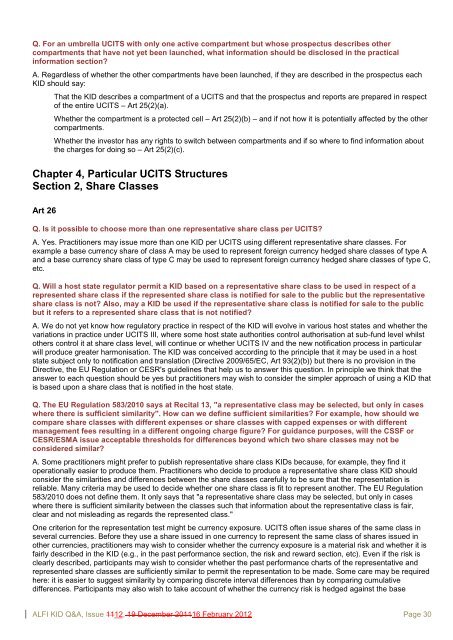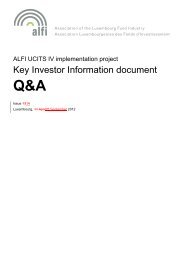Q&A - Alfi
Q&A - Alfi
Q&A - Alfi
You also want an ePaper? Increase the reach of your titles
YUMPU automatically turns print PDFs into web optimized ePapers that Google loves.
Q. For an umbrella UCITS with only one active compartment but whose prospectus describes other<br />
compartments that have not yet been launched, what information should be disclosed in the practical<br />
information section?<br />
A. Regardless of whether the other compartments have been launched, if they are described in the prospectus each<br />
KID should say:<br />
That the KID describes a compartment of a UCITS and that the prospectus and reports are prepared in respect<br />
of the entire UCITS – Art 25(2)(a).<br />
Whether the compartment is a protected cell – Art 25(2)(b) – and if not how it is potentially affected by the other<br />
compartments.<br />
Whether the investor has any rights to switch between compartments and if so where to find information about<br />
the charges for doing so – Art 25(2)(c).<br />
Chapter 4, Particular UCITS Structures<br />
Section 2, Share Classes<br />
Art 26<br />
Q. Is it possible to choose more than one representative share class per UCITS?<br />
A. Yes. Practitioners may issue more than one KID per UCITS using different representative share classes. For<br />
example a base currency share of class A may be used to represent foreign currency hedged share classes of type A<br />
and a base currency share class of type C may be used to represent foreign currency hedged share classes of type C,<br />
etc.<br />
Q. Will a host state regulator permit a KID based on a representative share class to be used in respect of a<br />
represented share class if the represented share class is notified for sale to the public but the representative<br />
share class is not? Also, may a KID be used if the representative share class is notified for sale to the public<br />
but it refers to a represented share class that is not notified?<br />
A. We do not yet know how regulatory practice in respect of the KID will evolve in various host states and whether the<br />
variations in practice under UCITS III, where some host state authorities control authorisation at sub-fund level whilst<br />
others control it at share class level, will continue or whether UCITS IV and the new notification process in particular<br />
will produce greater harmonisation. The KID was conceived according to the principle that it may be used in a host<br />
state subject only to notification and translation (Directive 2009/65/EC, Art 93(2)(b)) but there is no provision in the<br />
Directive, the EU Regulation or CESR's guidelines that help us to answer this question. In principle we think that the<br />
answer to each question should be yes but practitioners may wish to consider the simpler approach of using a KID that<br />
is based upon a share class that is notified in the host state.<br />
Q. The EU Regulation 583/2010 says at Recital 13, "a representative class may be selected, but only in cases<br />
where there is sufficient similarity". How can we define sufficient similarities? For example, how should we<br />
compare share classes with different expenses or share classes with capped expenses or with different<br />
management fees resulting in a different ongoing charge figure? For guidance purposes, will the CSSF or<br />
CESR/ESMA issue acceptable thresholds for differences beyond which two share classes may not be<br />
considered similar?<br />
A. Some practitioners might prefer to publish representative share class KIDs because, for example, they find it<br />
operationally easier to produce them. Practitioners who decide to produce a representative share class KID should<br />
consider the similarities and differences between the share classes carefully to be sure that the representation is<br />
reliable. Many criteria may be used to decide whether one share class is fit to represent another. The EU Regulation<br />
583/2010 does not define them. It only says that "a representative share class may be selected, but only in cases<br />
where there is sufficient similarity between the classes such that information about the representative class is fair,<br />
clear and not misleading as regards the represented class."<br />
One criterion for the representation test might be currency exposure. UCITS often issue shares of the same class in<br />
several currencies. Before they use a share issued in one currency to represent the same class of shares issued in<br />
other currencies, practitioners may wish to consider whether the currency exposure is a material risk and whether it is<br />
fairly described in the KID (e.g., in the past performance section, the risk and reward section, etc). Even if the risk is<br />
clearly described, participants may wish to consider whether the past performance charts of the representative and<br />
represented share classes are sufficiently similar to permit the representation to be made. Some care may be required<br />
here: it is easier to suggest similarity by comparing discrete interval differences than by comparing cumulative<br />
differences. Participants may also wish to take account of whether the currency risk is hedged against the base<br />
ALFI KID Q&A, Issue 1112, 19 December 201116 February 2012 Page 30

















